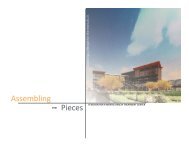Aaron Hanson Thesis Book.pdf - NDSU - North Dakota State ...
Aaron Hanson Thesis Book.pdf - NDSU - North Dakota State ...
Aaron Hanson Thesis Book.pdf - NDSU - North Dakota State ...
Create successful ePaper yourself
Turn your PDF publications into a flip-book with our unique Google optimized e-Paper software.
historical contextWith settlements increasing came the development of transportation networks.The most famous network is the Red River Ox Cart trail, which small piecesof can still be seen. These trails ran parallel to the Mississippi River alongthe east side, connecting southern areas, like St. Paul Minnesota, to northernareas, like the Red River Valley. The trails were mainly used by settlers andtradesmen. Another transportation method was by steamboat, which becameimportant in the 1850s and 1860s. (Minnesota, 1996).In the early 1850s, many people thought of St. Cloud as the head of the UpperMississippi navigation; however, this wasn’t the case. Sauk Rapids was theearly terminate for continuous navigation between St. Anthony and CrowWing (which was a major route) because of the shallow waters just north ofthe St. Cloud area. The major steamboat route was from St. Anthony to St.Cloud. Once you get north of Sauk Rapids, where the river is twenty feetdeep, there was navigation for a good two hundred miles (Reps, 1994). Thesteam boat era came to an end by the 1860s due to a severe drought that theMississippi suffered from.The Mississippi River is directly linked to the city of St. Cloud and its earlysuccess. According to Minnesota Department of Natural Resources (1975),the area along the Mississippi River corridor from St. Cloud to Anoka hashistorical values of “statewide significance because of the integral part whichthe river has played in the exploration, settlement, and development ofMinnesota” (p. 3).Interesting Facts About St. Cloud• 1867, first bank opened.• 1870s marked a period of growth in the downtown area. Mainly consistedof blacksmiths, wheelwrights, grocers, druggists, hardware men, andbankers.• 1883, first gas lamps installed as well as first phone service.• St. cloud was headquarters for the Red River Oxcart Co.• By 1880s, St. Cloud became a well equipped city with complete electricand gas lights, piped water, and sewage systems.• A tornado on April 14th, 1886, destroyed most of downtown Sauk Rapidsand made business owners move existing facilities and services to St.Cloud. This led St. Cloud into being the dominant city in the area andinto an economic boom. In 1880 to 1892, the population of St. Cloudexpanded from 2,500 to nearly 10,000 people.Information found from (Reps, 1994), (“Historic Downtown,” n.d), and(Minnesota, 1996).71





